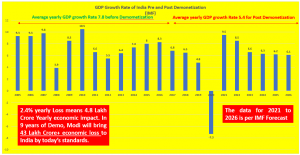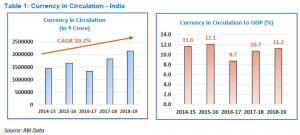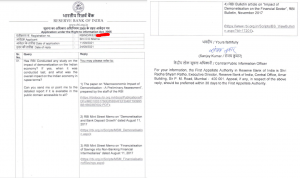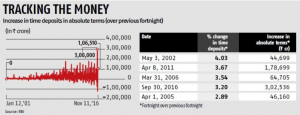

We will begin with a historical fact. Mao started “The Great Sparrow Campaign” in 1957–58 under its “Four Pest” initiative. Chinese leadership felt Sparrows ate a lot of food grains, and they eliminated millions of sparrows from China. Sparrows not only ate grains, but they also ate insects. As a result of sparrow elimination, locusts grew, and they destroyed crops several times more than sparrows ate. An estimated 36 million people died of the worst humanitarian disaster known as great famine, which resulted after that. We can find solace in the fact that Mao’s intent was good. Now let us come to India.
Five years ago, on 8th November 2016, Mr. Modi announced the Demonetization of INR 500 and INR 1000, which he termed “war on black money.” But, rather than finding black money in Panama, he was searching our Pajama for it.
Demonetization, as per Modi, was to deal with three things — Counterfeit Currency, Terrorist Financing, and Black Money. The goal post changed thereafter as the situation evolved.
Black Money
In the simplest term, Black money proceeds are usually received in cash from underground economic activity and, as such, are not taxed. If the taxes are paid, earnings are registered, and it no longer is black. However, black money does not remain black forever. Those who generate black money also convert it into white. See this to understand how black becomes white — 5 Ways People Use to Convert Black Money into White Money. Hence it is difficult to assess or demarcate black money.
India’s Black Money in Cash During 2016
It isn’t easy to assess accurately how much black money was in cash. It is based on various research and ballpark numbers to arrive at a broader estimate. However, at the time of demonetization, the available information indicated that nearly USD 500 Billion had been stashed abroad and not in India. Central Bureau of Investigation submitted a report based on their findings in 2012. See Black money: Indians have stashed over the US $500bn in banks abroad, Says CBI.
Now Target of Demonetization is not this money that is abroad. The target was money which is in India, and that too in cash. So we checked the quantum of black money, which continuously was generated. As per the National Institute of Public Finance and Policy, National Institute of Financial Management, and National Council of Applied Economic Research, India’s black money was 30% of India’s GDP in 2013.
India’s GDP in 2012 was nearly USD 1800 Billion. 30% of this is USD 600 Billion. So, total Black money is 600 Billion, out of which 500 Billion was abroad. It means 83% of our black money is kept abroad, and 17% was in India. So, let us create a benchmark to estimate the quantum during the year 2016.
Now let us understand how much black money was in 2016 when Modi announced Demonetization. We are talking about USD 2200 Billion economy’s USD 750 Billion Black Money (30% of the economy), and out of which USD 127.5 Billion (17%) was in India, which is equivalent to INR 850,000 crore black money (INR 67/- conversion rate in 2016). But this is not all cash. So we will not have to understand the cash part of this money.
As per Income Tax in India, cash recovery is 6% of the entire black money they recover. Let us use this as a thumb rule that 6% of black money is in cash. See the report Why govt’s demonetisation move may fail to win the war against black money. Hence, the black money Modi was targeting was 6% of 8,50,000 Crore which comes out to be INR 51,000 crore in cash.
Fake Currency in Circulation
The value of the fake currency in circulation at any given time is Rs 400 crore. It is estimated that 250 in every million notes are fake, according to this 2015 joint study by the Indian Statistical Institute and National Investigation Agency, to analyze fake-currency trends, especially those originating across India’s borders. The same money is used in financing Terror.
Cost of Demonetization
There are two types of cost which come to our mind. One is the direct cost like printing currency, logistics cost of bringing new currency and disposing of old currency, calibration cost for ATMs, etc.
The other cost is broader and linked to economic impact. For more than three months, the banks were busy churning out new cash. It was a huge opportunity for some but unimaginable loss for the country. Banks collectively lose around 7,500 crores per day if banking activities are prevented.
Apart from it, the organized and unorganized sector has losses. The entire small and medium business sector was devastated as they mostly used cash. It led to huge cash flow issues in the unorganized sector, much of which closed down.
Within days of the Demonetization declaration, when most people called it Masterstroke, Prof R Kavita Rao of the National Institute of Public Finance Committee estimated the economic impact of 12 Lakh crore due to demonetization. We find economic impact is more than 43 lakh crores.
We have tried to simplify by measuring the impact on GDP. Indian economy lost GDP, and despite GST implementation, it will continue to bleed. . A 2.4% drop in GDP translates into a 4.8 Lakh crores loss to the economy every year. If we calculate the average growth rate of India pre-Demonetization and Post demonetization from 2005, it indicates an overall economic impact will be an excess of 43 Lakh crores by 2025.

Printing new currency required additional INR 8000 crores. Another INR 100 crores were spent on calibrating the ATM machines.
The above expenditure was made to recover 51,000 crore black money in cash and to make INR 400 crore in counterfeit currency useless. This does not make sense by any stretch of the imagination. We are not sure who gained from it but the Nation lost badly.
Outcome
Let us understand the outcome of demonetization against its objectives.
1. Black Money: RBI said Rs 15.31 lakh crore of total Rs 15.44 lakh crore of old currency notes had returned to the system after demonetization in November 2016. Only 13,000 crores did not come back. It was a monumental failure of judgment.
2. Cash in Circulation: The cash was previously 11–13% of the GDP, and still, it is 12% of the GDP. This again indicates the hypothesis that cash circulation will reduce, went for a toss. See the figs below from RBI.
 Source https://m.rbi.org.in/Scripts/PublicationsView.aspx?id=19417
Source https://m.rbi.org.in/Scripts/PublicationsView.aspx?id=19417
3. Terror: Data indicates that terror attacks and casualties on our men in uniform continue. We have provided the data below for J&K, which was published by CNBC earlier. This indicates that there was no impact on terror, and in fact, the activities increased further.
 Source: MoneyControl
Source: MoneyControl
4. Fake Currency: The fake currency market got a shot in the arm with INR 2000/-. It became easier to replicate and carry, and it may have helped bad guys. Fake Currency doubled in a year after demonetization.
It seems almost all the purpose which was laid down, in the beginning, was defeated.
Unintended Benefits
One of the unintended benefits of this is the increased circulation of digital payments. But Digital Payments have always been on rising. But it will be fair to give credit to the Demonetization initiative for accelerating it. Hopefully, it improves the formalization of the economy.
Key Questions
1. India counted the currency up to 99% in nine months (August 2017) and another 0.3% to reach 99.3% took over a year (August 2018). What was unfolding between the twelve months to take 99% to 99.3%? Was there a massive currency exchange happening behind closed doors? You can see the video from The Quint.
2. Against a RTI, RBI replied that there was no final economic assessment done. There is only a preliminary report on early days, but why has RBI and MoF failed to conduct any economic evaluation. The report they indicated against RTI was a preliminary report of March 2017 and even before the economic impact was felt. You can read their report here: Macroeconomic Impact of Demonetisation – A Preliminary Assessment.

3. Did RBI give the nod to go ahead? Did RBI raise any concerns? The reports available in the public domain indicates that RBI refused to accept Modi’s justification and was against the note ban. So why did they go ahead when central bank economists were against it? What was the motivation?
4. Did they remove Raghuram Rajan for refusing to entertain the note ban? See how India shot the wrong general. The question remains was he onboard? Was it discussed with him?
5. During the investigation, we stumbled upon the CBDT report during 2011 that the demonetization was indeed discussed during the MMS regime, and it was dropped, sighting a bad idea.The report “Measures to Tackle Black Money in India and Abroad” created by committee headed by CBDT chairman indicates and we quote “Demonetization of high denomination currency notes is believed to be one of the methods to ‘kill’ the extant black economy, and to curb the generation of black money. In India, demonetization was implemented in 1946 and 1978. Experts have criticized that demonetization did not achieve the objective it was aimed at. Further, inflation over the years and a large cash economy require higher denomination currency notes to keep the cost of money management of the economy low” [3.32]. Further, it says and I quote “One common demand from the public is that high denomination currency notes, particularly `1,000 and `500, should be demonetized. In this connection, it is observed that demonetization may not be a solution for tackling black money or economy, which is largely held in the form benami properties, bullion and jewellery, etc” [9.1]. Now, this was in 2012 when the Government knew that it was going to fail; multiple experts quoted that it would not work; why Government has to go ahead suddenly ignoring expert comments and without any due diligence?
6. If demonetization was a success, why did Mr. Modi or any BJP member not claim success in any pole campaigns or anywhere?
7. Mr. Modi asked for 50 days to show the results. Do we really know what happened after 50 days?
8. Did Modi consult any expert for demonetization? Modi ignored expert committee recommendations. Modi ignored economists, but we are wondering who agreed to it other than Modi?
9. At the time of demonetization, elections were due in some states. Did anyone give a novel idea to paralyze the cash held by opposition members through demonetization? There is no evidence of it, but its precise situation and other factors discussed in this study indicate this as one of many possibilities.
10. Days before demonetization, the inflow in Banks increased exponentially. 3 Lakh crore were deposited within 15 days before demonetization between September 15, 2016, to September 30, 2016. This incident was unprecedented and had never been seen before since 2001. Arun Jaitley later explained it as disbursal of arrears which was incorrect. The arrears were 45,000 crores. So why does the government lie about the spike? Was it something they were trying to hide? We will leave it to your imagination. Meanwhile, you can read the full report: Unravelling the mystery behind Rs 3-lakh crore deposits in 15 days.

Contrarian Views
There is always room for disagreement. I have tried to preempt some.
1. The economic impact on GDP is not because of Demo alone.
Ans: That is the reason we considered 20 years. Two big things Modi did — Demo and GST implementation. While Demo was negative other was to give positive impact. The impact of the Demo shown may be lesser here as a result of this.
2. The loss of GDP is largely attributed to COVID.
Ans: This is not the case. The decline was followed by recovery. See 2020 decline and 2021 and 2022 recovery. The economy is like a rubber ball that bounces back when it hits the floor(rubber ball theory). Our economy faced a great financial recession in 2008, which was much bigger than what we saw in COVID. The long horizon of calculation over 20 years smoothens those wrinkles.
3. The impacts will be visible over a long period due to formalization.
Ans: While it may have some positive effects, those are minuscule. The formalization can be done without demonetization. The demonetization created injury, which generations will pay to have some positive unintended impacts.
Conclusion
We can conclude that enough research was available to indicate that this may not work with known facts. MMS did conduct a detailed study to control black money, and demonization was one of the options. Experts after experts discarded this idea. Modi also understood the impact and magnitude of the challenge and the injury it would cause to the nation. With one signature stroke that night, he inflicted more wounds that our enemy could have caused with a thousand cuts. He went ahead with a motivation which we may never understand. None of us can escape the blame. There are cheerleaders of destruction, and there are those who cannot prevent it. ![]()
____________________
Also Read:
The Saga of Modi’s Success in Halting India’s fight against Hunger
Why not 40 pc tickets for women in Punjab and elsewhere?
Chinese Naval Strategy’s Covert Dimensions
Punjab – How a deadly cocktail of Agri-Water-Energy nexus going to destroy it?
North Pole and the ideological conflict of RSS & Hindutva
Jallianwala Bagh Renovation – A Memoricide of Punjab
Politics of Symbolism: Dalit Chief Ministers in India

Disclaimer : PunjabTodayTV.com and other platforms of the Punjab Today group strive to include views and opinions from across the entire spectrum, but by no means do we agree with everything we publish. Our efforts and editorial choices consistently underscore our authors’ right to the freedom of speech. However, it should be clear to all readers that individual authors are responsible for the information, ideas or opinions in their articles, and very often, these do not reflect the views of PunjabTodayTV.com or other platforms of the group. Punjab Today does not assume any responsibility or liability for the views of authors whose work appears here.
Punjab Today believes in serious, engaging, narrative journalism at a time when mainstream media houses seem to have given up on long-form writing and news television has blurred or altogether erased the lines between news and slapstick entertainment. We at Punjab Today believe that readers such as yourself appreciate cerebral journalism, and would like you to hold us against the best international industry standards. Brickbats are welcome even more than bouquets, though an occasional pat on the back is always encouraging. Good journalism can be a lifeline in these uncertain times worldwide. You can support us in myriad ways. To begin with, by spreading word about us and forwarding this reportage. Stay engaged.
— Team PT


Copyright © Punjab Today TV : All right Reserve 2016 - 2025 |